To introduce myself, I'm a college student who's been passionate for Chess ever since I was 12 or 13. The computer program "Battle Chess" by Interplay (1992-93) was my very first experience of Chess; something that I'll always hold dear to. I've never actually truly developed my Chess skills, and I haven't played very many opponents beyond BattleChess. I've also never won a real game against BattleChess, because the thing litterally never "makes a single mistake." I've taken a break from the board game for a few years and currently started resuming playing games. My chess rating lies in the 900-1200 range. ONce I have enough time in later years, it might just become better.
Some time as a 15-year-old, I developed this chess piece called the Magician. I recently started writing a document of instructions on the piece, hoping to share with other Chess players. However, as I am just getting back into Chess and studying games from more advanced players, I realized that this piece really isn't up to par; at least in my opinion. I still want to share that piece with you guys and see what you think because I've already written instructions on it. lol And, any constructive criticism from more advanced players would greatly be of benefit.
Hope you guys at least minimally like my creation.
~~~BattleChessgn18~~~
My instructions pasted here (since attachment feature won't allow me to attach .doc documents)
The Magician: Chess Variant BattleChessGN18 style
I – The Piece
The magician much resembles the pawn in two ways: her moving powers is different from her capturing one, and she can be promoted to any one of four more powerful pieces when a certain condition is met. (You will learn that in both the magican and pawn's case, the required condition for promotion involves the pawn's advancement across the board! More on that in the "Promotion" section.)
To play the Magician in Chess, a player switches out one of the Bishops that has already been moved and places her in his (the bishop's) place; if neither Bishops has been moved yet, option to put her in the game won't yet be available until one has been. (There’s also another possible way for the Magician to appear on the board that doesn’t require a Bishop: by pawn promotion. More of this is mentioned later on.)
She may be used only once per player per game. Once switched in, she may not be switched out again for the bishop in a later turn, remaining a Magician for the remainder of the game. If she has been captured, the other bishop, if still on the board, does not have the option to be switched out for her. Finally, the switch counts as one move; it’s now your opponent’s turn.
II – Powers
a. Movement and Capture
The Magician can move in any diagonal direction (like the Bishop) over as many as two squares possible. When she captures, however, she can do so in any direction, crosswise or diagonally (like the queen) over two squares maximum.
(For clarification, she cannot land herself onto a square that's directly forward, backwards or sideways unless there is a piece for her capture! e. g. Standing in d5, if there isn't an opponent's piece on d6 for her to capture, she cannot move forward one square to d6; this is likewise so for d7.)
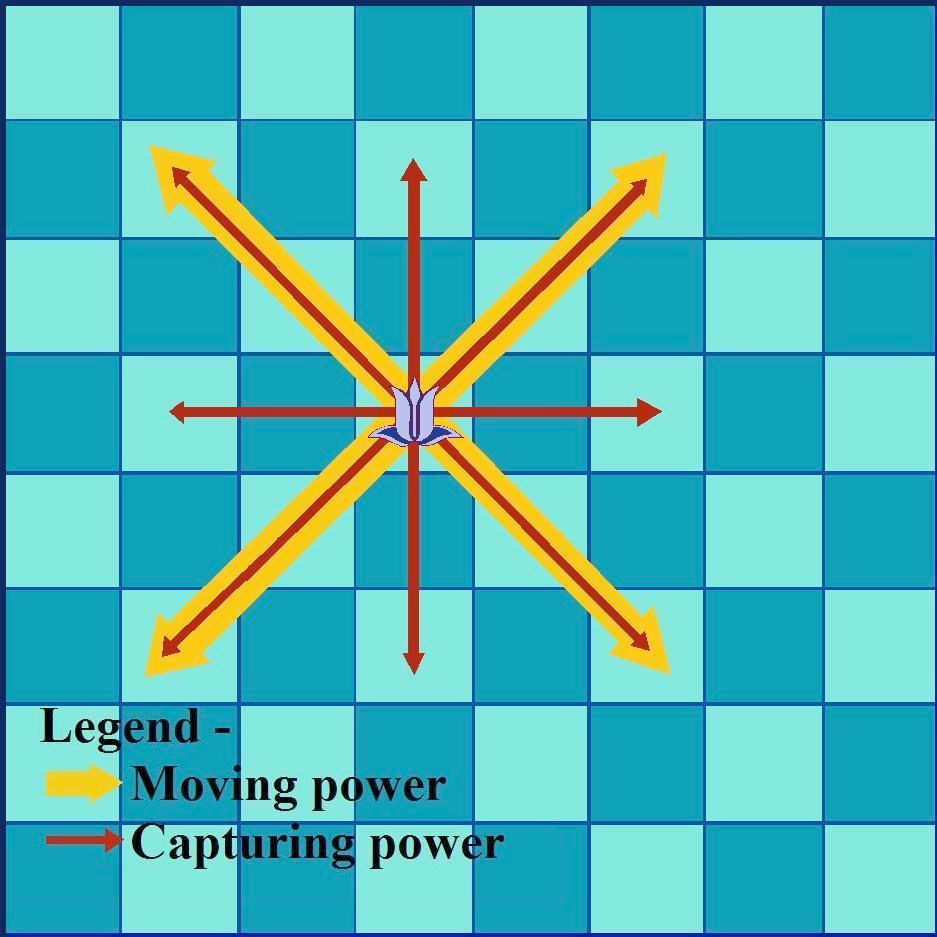
Because of her limited range, players might find her more useful as a defensive piece. On the other hand, what she lacks in mobility, she makes up in her special attribute.
b. Leaping Abilities
The Magician is unique from the rest of the chess pieces in that there are two leaping abilities specially characterized her.
1 - She can leap over any piece adjacent to her, yours or your opponent’s, to capture an opponent piece directly on the other side of the leaped piece. (Only to capture, though!)
2 - If she is on a square at the edge of the board (e. g. a3, f1, c8, etc.), she has the option to move/capture on the square directly across the board, regardless of any piece that may stand in that rank or file. (e. g. 3.Ma3-h3, even if 2 of your pawns and a knight are on the 3rd rank, 1.Mc1-c8 even when there’s a pawn on c2 and one on c7, etc.) If she is at a corner, she may transverse to any one of the other three corners. (e. g. On a1, the Magician has the option to leap to a8, h8 or h1.).
III – Promotion
(As mentioned earlier) The Magician has the potential to be promoted to one of four more powerful pieces after one of a few conditions is met; which of the four pieces becomes her promotion depends specifically on which condition was met. The four promotional pieces are the following, listed by rank of power:
. - High-Priestess/High-Sorceress
. - Arch-Bishop
. - Chancellor
. - Prime Minister
a. Promotion to High-Priestess
1) Conditions for promotion - Most players would find themselves almost always promoting the Magician to High-Priestess (HP) because the condition for them to do so are the easiest to meet. One of the following two conditions must be met for promotion to HP –
. - A pawn must capture an enemy knight while the magician is in play. (The knight's capture is specific to HP; capture of the other minor and major pieces, as will be mentioned soon, are specific to the other promoted pieces)
. - One of your pawns must reach the 6th rank anytime the magician is in play. (Any pawn that is already on the 6th or 7th rank when the Magician was switched in does not count.)
2) Powers - Though the weakest of the four promotional pieces, the HP isn’t exactly weak. Her moving power goes in any direction over two squares maximum (which is the same as the Magician’s capturing power). Her capturing power combines her (HP) moving power with that of the Knight’s, giving her a vast 5x5 area attack around her immediate location. (whereas the Queen, Rook and Bishop have a line attacks)
(And, the leaping abilities of the magician are still intact!)
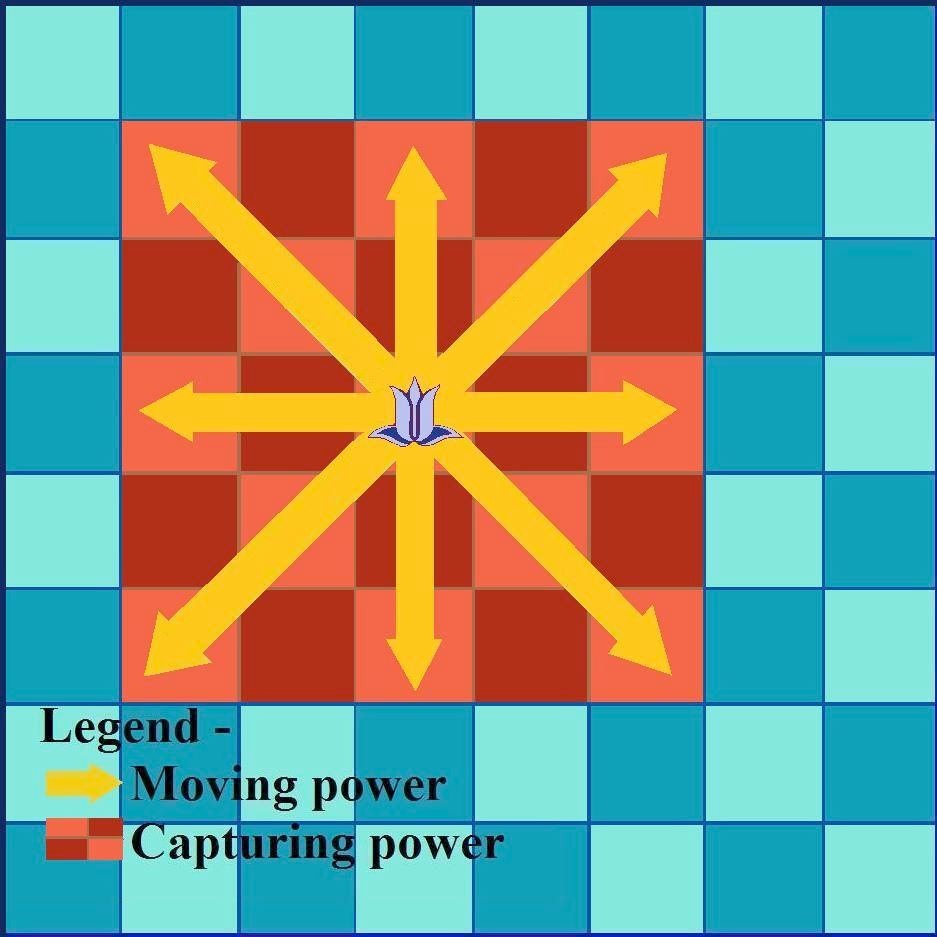
b. Promotion to Arch-Bishop, Chancellor or Prime Minister
1) The conditions for promotion – As a pawn-capture of a knight would promote the Magician to HP, a pawn-capture of the other minor/major pieces would likewise promote her to one of the other three pieces; each, which, as would be explained, would correspond to the powers of the captured piece.
. - A pawn-capture of a Bishop would promote the Magician to Archbishop.
. - A pawn-capture of a Rook would promote the Magician to Chancellor.
. - A pawn-capture of a Queen would promote the Magician to Prime Minister.
(It’s not so likely that a pawn would capture a Queen, since their power dynamic would naturally cause players to steer away from such a danger before it really becomes a viable threat. However, when it does, the option is there!)
2) Their powers - The Arch-Bishop's (AB) powers combines that of the HP and the Bishop’s, giving him an unlimited diagonal line attack in addition to the HP's area attack. Likewise, the power of the Chancellor combines that of the HP and the Rook’s. Finally, the power of the Prime Minister combines that of the HP and the Queen’s, making him the most powerful piece on the board! (Though, he's the least likely of all chess pieces to make it onto the board.)
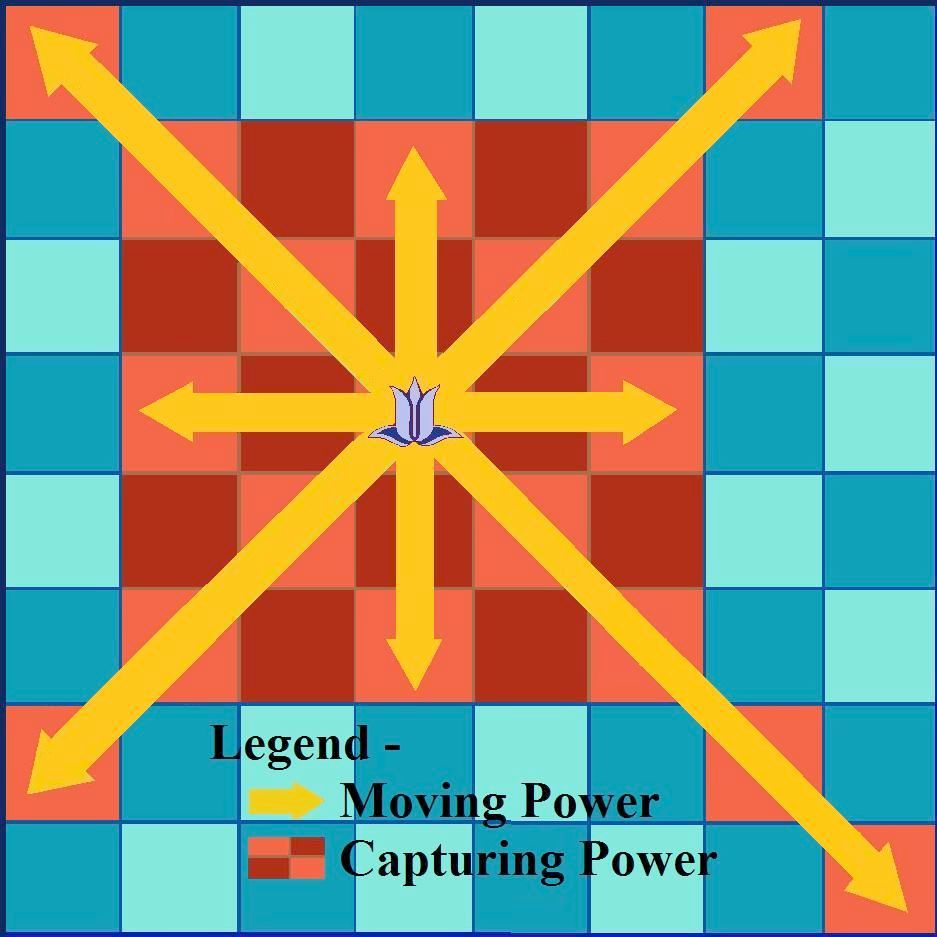
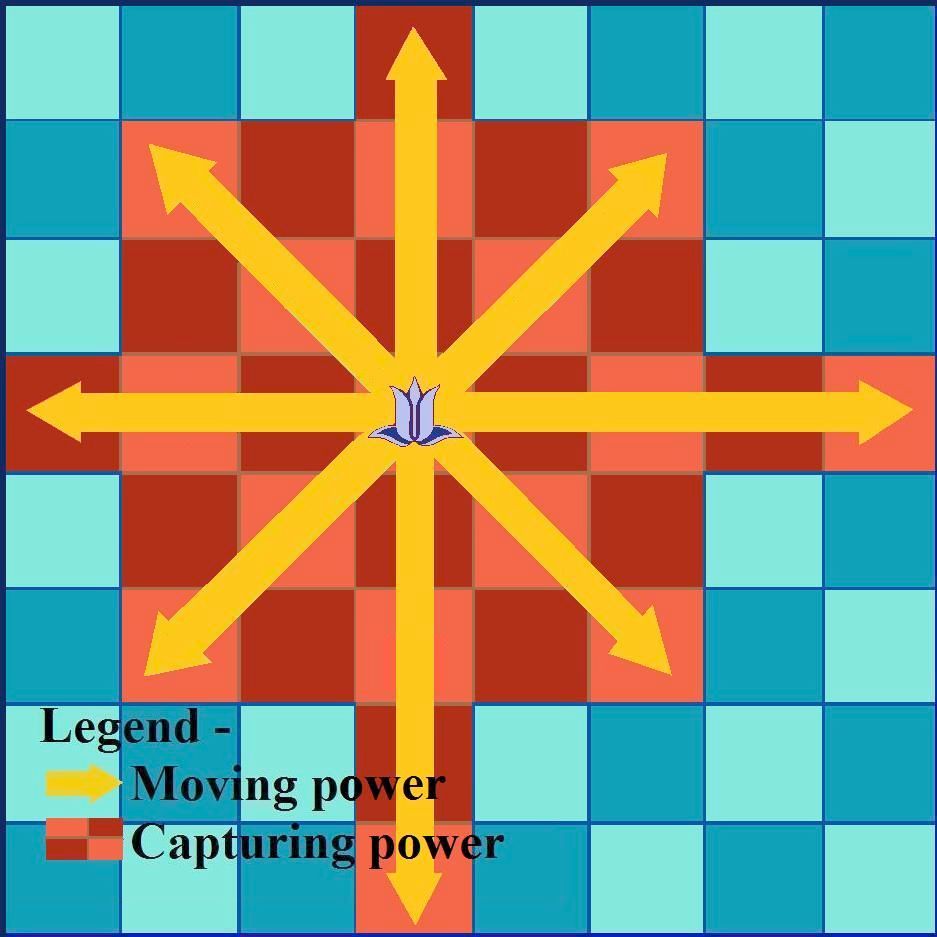
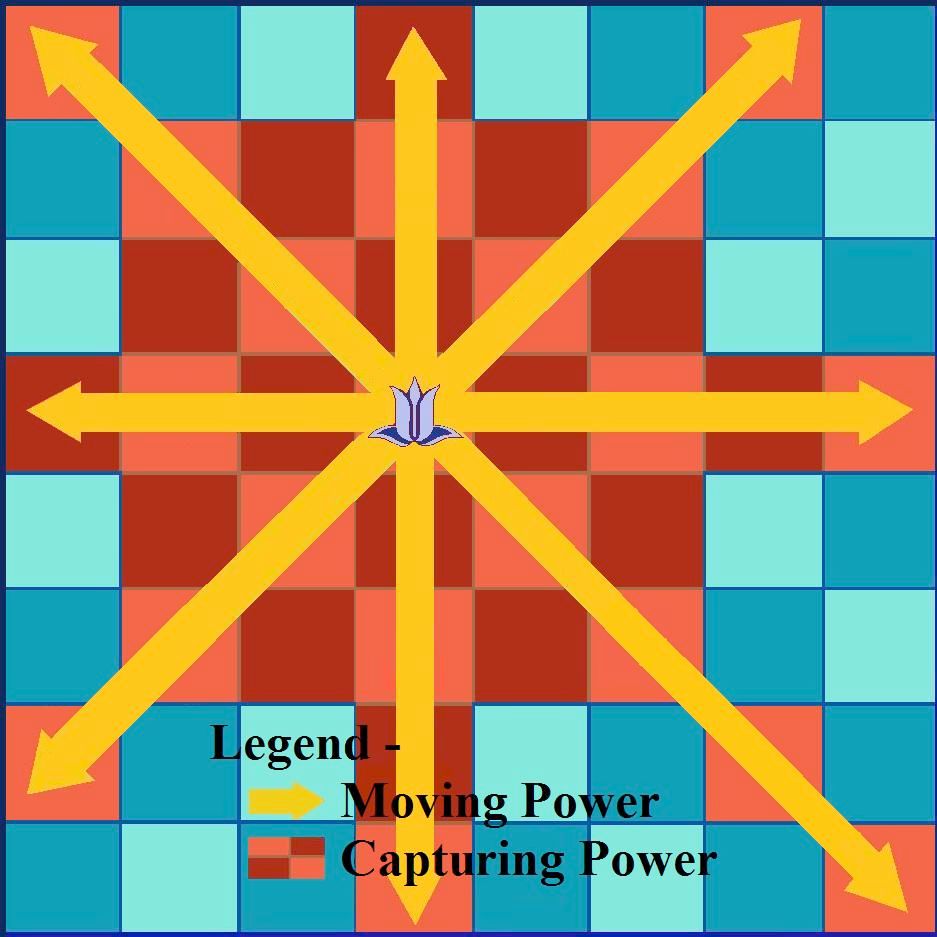
When it comes to leaping over a piece to capture an opponent's piece, as a rule, they can only leap over a piece directly adjacent to their own in order to capture an opponent piece two squares directly over. (E. g. Even if an Archbishop can move infinitely diagonally, he can't, standing on b2, capture an opponent piece on g7 (diagonally 5 squares upwards to the right), if there is a piece standing in between the two on c3, d4, e5 or f6. He can, however, capture an enemy piece on d4 even when another piece is standing on c3, which is directly adjacent to him.)
The conditions to promote the Magician to any of these three pieces are notably harder to reach. However, when reached, the reward is a chess piece more or less powerful than the Queen!
Also, as previously mentioned, another way for the magician to appear on the board is through pawn-promotion. Coming with this too is yet another condition for Magician-promotion.
IV – Promotion by pawn-promotion
I stated earlier that the Magician can't be used if neither Bishops has moved yet. This is a (white) lie. If the Magician has not already appeared on the board, she may be chosen as one of the pawn’s own promoted pieces; in this situation, both Bishops and she can be on the board at the same time.
One of the benefits of her appearing on the board through this method is the possibility of instant promotion. If at least one of your opponent's Knights is still on the board, the Magician instantly gets promoted to High-Priestess. Likewise, an enemy Bishop still in play instantly promotes her to Arch-Bishop, an enemy Rook to Chancellor and an enemy queen to Prime Minister; the highest-ranking enemy piece in play during the pawn's promotion is what will promote her correspondingly. The one exception to this is an enemy Magician, in which case, the pawn promoted to Magician will simply remain an un-promoted Magician.
V – Checkmate
Check-mate by the (un-promoted)Magician alone is equivalent to a checkmate delivered by two knights and a king: while it’s definitely possible, it is most difficult! The short range of the Magician and the fact that she can only move diagonally will obviously make for a rather easy escape of your opponent’s King. When it is done, checkmate would generally be delivered by trapping the opponent's King at the edge of the board.
If anything, checkmate should be delivered in one of her promoted stages. Among those things that are special to the Magician-promoted pieces are some of the unique (and rather dangerous) ways in which they can deliver checkmate -
. - By placing the Magician-Promoted piece on a square directly adjacent to the opponent's King anywhere on the board, if that adjacent square is protected by one of your other pieces; if the adjacent square isn't protected, the enemy king would merely be in check, in which case he could come out of it by capturing the Magician. (E. g. If the opponent's king is on f6, checkmate can be delivered on f5, e5, e6, e7, f7, g7, g6 or g5, assuming that another of your own piece is protecting that square.)
. - If the opponent's King is on a rank at the edge of the board (ranks 1 and 8 ), by placing the Magician-promoted piece directly two ranks inward on the exact same file; or one file over, to attack like a knight (e. g. If the opponent's king is on e1, checkmate can be delivered on e3; or on d3 or g3, attacking like knight.)
. - If the opponent's King is on a file at the edge of the board (files a and h), by placing the Magician-promoted piece directly two files inward on the exact same rank; or one rank above or below, to attack like the knight (e. g. If the opponent's king is on a5, checkmate can be delivered on c5; or on c4 or c6, attacking like knight.)
One of the unfortunate things about a King who suffers from a Magician-Promoted piece's attack is that he can't escape by the typical block method (putting a piece in between the line of attack), since this method is overridden by the Magician's ability to leap! Also, it might be interesting to note that once the opponent's King is in check by your Magician-Promoted piece, he is usually doomed, since perpetual checking by consistently moving one consecutive square closer is a convenient and likely maneuver!
VI – Chess notation
In recorded games, the Magician should be notated (as you saw in an earlier example) with a capital M.
Key –
M – Magician
H – High-Priestess
A – Arch-Bishop
C – Chancellor
P – Prime Minister
"B{{file}}{{rank}}=M": Bishop switched out for the Magician
".{{file}}6 (M = H)": pawn reaching 6th rank promotes Magician to High-Priestess
".xB{{file}}{{rank}} (M = A)": Magician Promoted to Arch-Bishop
".xR{{file}}{{rank}} (M = C)": Magician Promoted to Chancellor
".xQ{{file}}{{rank}} (M = P)" Magician Promoted to Prime Minister
VII – Discussing Material
This is a tricky area that’s open to debate. As of current, I put the magician at around 2.5 or 3 points of material: she is more or less powerful than the bishop and knight, due mostly to her ability to threaten pieces up-close but lacking mobility beyond a short-range diagonal line. The short range itself would make her worth less than the bishop, but the lost is made up by her ability to attack pieces crosswise and across the board.
The High-Priestess is probably at least as powerful as the Rook at 5 points; perhaps 6. While she too has a weak mobility that can’t attack across the board like the Rook (unless she’s on the edge of the board), she retaliates with a powerful area attack, which the Rook doesn’t have. Consider the following: if a knight is worth 2.5 or 3 points, the High-Priestess is double this, since she can capture like him as well as capture and move in all directions as far as he can. In those positions where she can execute a leaping ability, she would be a little bit more, perhaps at 6.5 points. (In the same way that certain positions make the knight worth more than the bishop by a slight, and vice versa.)
The Arch-Bishop, Chancellor and Prime Minister are respectively set to 8.5 (or 9) points, 10 (or 11) points and 16 points. I need only discuss the AB’s material points, since the Chancellor and Prime Minister’s grand powers don’t need a material point analysis to understand why they are so powerful. (In other words, they win!) The AB's direct moving power is almost as powerful as the Queen, except for the fact that his crosswise movement and attack are pathetic compared to the queen’s absolute unlimited range in all directions. This alone would set him at around 7 points. Then, adding on the capability to capture like the Knight (half the knight’s material is 1.5 or 1.25) puts 1.5 points back in, placing him at 8.5 points. Finally, considering the AB's leaping abilities (and the fact that, due to his unlimited diagonal range, he has easier access to it than the High-Priestess and Magician do), an added half material point would set him at 9 points.
VIII – Development of these variant Chesspieces
a. The Original Idea behind the Magician
This section covers why the Magician was created to move the way she does. Hell, why is she even called the Magician? Where did the Arch-Bishop, Chancellor and Prime Minister even come from?
Ever since medieval Europe (or perhaps even before then), witchcraft has generally been regarded poorly in the Christian/Catholic Church. Supernatural practitioners have been socially limited to cryptically private venues or, more so, simply shamed/mocked in public. (Consider the way psychic people and ghost mediums of today are often regarded!) As such, the Magician’s range is only as good as two diagonal squares, where as the highly-regarded Bishop’s range is unlimited. However, the King’s ignorance of all her potential abilities doesn't take it away: she has secretly aided troubled soldier’s on the field, and battles were mysteriously won with no concrete reason. This translates into her ability to attack crosswise and, furthermore, leap over pieces, abilities which the Bishop doesn't have. When it's realized that the King's sudden victories were owed to the Magician's fore-unbeknownst aid, he would return the favor and regard her with a higher status. This concept became the magician's condition for promotion: when pawns have successfully reached an advanced rank or have captured a more powerful piece, she would gain the ability to move crosswise and attack like the knight; an "unorthodoxed" special move that was previously "denied" her)
It may also be interesting to bear in mind, her presence on the board does seem to give pawns more power: enemy pieces have to either work harder to capture them, prevent their advancement or to simply avoid them, specifically the highly-valued long-ranged pieces!
b. The Arch-Bishop and Chancellor
In truth, I did not invent the Arch-Bishop and Chancellor. At least not completely. In actuality, I derived the names from Grandmaster Capablanca's own Chess Variant, the "Capablanca Chess". I had once read about a highly renowned player who created two pieces, respectively combining the powers of the bishop and knight and that of the knight and rook. The piece that had the combined powers of the Rook and Knight was called the “Chancellor”, and that that combined the powers of the Bishop and Knight was called the “Arch-Bishop.” I realized that I could add my own variant version of these already-variant pieces, since, around this time, I realized that I needed to give the Magican a more "offensive" role: as mentioned in the beginning, her pathetic 2-square limited range likely renders her much more useful as a defensive piece. And so, I created subsequent variant pieces with the same names that would combine the powers of the High-Priestess and the Bishop and that of the HP and the Rook.
My version of the Chancellor and Arch-Bishop do somewhat resemble these earlier variants created by Capablanca: Mine could capture like the Knight and bishop and like the knight and rook!
Finally, the Prime Minister was added so as to have a piece that also combined the HP with the Queen; since there were already ones that each combined the other minor and major pieces. The historic governmental office of Prime minister was not nearly as powerful as the King but was still a highly influential political position, much more so than the Chancellor's, and so, he became the official name for the last Magician-Promoted piece.
IX – Conclusion
I’ve always wanted to invent a new chess piece because of my grand love for the board game. I currently like the idea of making it widely known by chess players around, starting with your participation in reading this document. I don’t think it anywhere near finished in development and hope that your constructive criticism might aid me in making this variant better. It would be great if those who do try her out would let me know how she would benefit or hurt their games.
Where the Magician will go in the end, I don’t know for sure. Maybe people will absolutely love her, and, if I'm completely absolutely optimistic, maybe she (or a different version of her) will even become a part of commonly played games in the far future. Maybe she’ll be nothing more than a fun or silly experiment of today, eventually to be discard and moved on from. One thing is certain for the time being: I just won’t know until. However, as my elder sister taught me, it’s never a bad idea to dream big!
